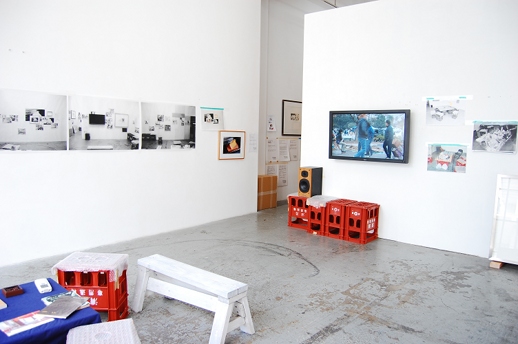A Vendor of Junk and Contemplation
It is said of Koki Tanaka’s works, enjoy what the artist shows you and what he does not. The artist’s video may be ordinary social constructions but are simultaneously revealing, reflective and subversive as they work with the potential of the everyday encounter. For his fourth solo exhibition, the artist has returned from his current Los Angeles base for a show at Aoyama | Meguro as well as to exhibit works at the Yokohama Triennale. What these latest works show is a restless Tanaka continuing to investigate the potential idiosyncrasies and ironies of every day life while engaging with a social critique of modern economy and its darling offspring — the art world.
For the centerpiece of this exhibition, “Someone’s junk is someone else’s treasure.” (2011, HD Video, 11 minutes), Koki Tanaka (b. 1975) drew upon two works, “Blizz-aard Ball Sale” (1983) by David Hammons as well as cartoonist Yoshiharu Tsuge’s “Muno no Hito (Man without Talent)” (1985). As both of the cited artworks essentially feature protagonists attempting to sell useless objects, Tanaka engages in his own business venture by situating himself at a Los Angeles weekend flea market to sell palm fronds. The fallen, dried leaves are found almost anywhere on the streets of Los Angeles and local residents are quick to sweep them away if not deem them a nuisance. Presented in documentary form and edited by the artist himself, Tanaka engages as a street vendor and discusses his product as well as potential transaction with passersby.
While these two cited influences no doubt converge into constraints, they are also permissibly liberating for the artist and it is within these precedents that Tanaka relies on history and a (forced) lack of expectation.
Tanaka’s documentary video relies on familiarity but more so on unexpectedness, which however cliché, the artist persistently tries to evade in varied form of practices seen in these works. In doing so, Tanaka follows Hammons and Tsuge in albeit more modern footsteps, and props a critique of the art world twenty-eight years later. For Tanaka, not much has changed and while critiques of modern economy and the art world pervade, it’s the artist’s perspective that has changed.

Viewers of the video may watch, and wait, for a transaction to occur yet Tanaka has sidestepped that and the ephemeral act which transpires is Tanaka selling his own contemplation. A non-commodity which developed through the various dialogs with visitors. For the artist, at the heart of this work is that through a process of discovery, and out of something useless and relatively functionless, something (potentially) useful and functional developed — and this is creation and, at the same time, a re-examining of the processes of creation itself. Holding on to this idea Tanaka discounts much of narrative in the video, deliberately editing in favor of longer cuts, not only to stress the individual occurrences but also for viewers, no matter when they start watching, to effortlessly develop a context.
Also in this show are two other series of photographs, “I Spend Time in a Park Until the Jell-O chilled out” (digital print, 2010) and “Everyday Statement (cheese toast)” (photograph, 2010). In the former, Tanaka relied on the weather and a loose set of expectations on the probability of the substance coagulating, while the latter allowed the artist to observe the infinite shape and texture of his sculpted and melting breakfast.
Still a bit of a prankster and with a noticeable sense of humor when I spoke to him, Tanaka is less concerned with playing a joke than critiquing the very environs in which he practices: the gallery as display case and the flea market as site for transactions and economic critique. While “Someone’s junk is someone else’s treasure.” mocks at the absurdity of exchange and nature of commodity, as did the cited predecessors, Tanaka seemed more attune to equating the formats of flea markets and art fairs; the latter, for the artist, less welcoming to performance pieces and more focussed on neatly arranged collectables. Taking his social commentary a step further, Tanaka has also been visiting the gallery to rearrange his pieces, as a passing joke to artists overly concerned with the inch-by-inch positioning and perfection of their work.
Indeed, at the core of Tanaka’s practice is placing not only his works, but himself in different contexts in which he can participate or others can interact together. Amounting his practice to a portable form. At this year’s Yokohama Triennale, Tanaka will exhibit a video of a model getting a haircut by hair stylists from a variety of social and cultural backgrounds. As Tanaka continues to work with documentary form, through film and photograph, he is one more artist whose participatory work blurs the line between art and documentary.
“Someone’s junk is someone else’s treasure.” (2011, HD Video, 11 minutes) was produced in conjunction with The Box, Los Angeles (http://theboxla.com/).



